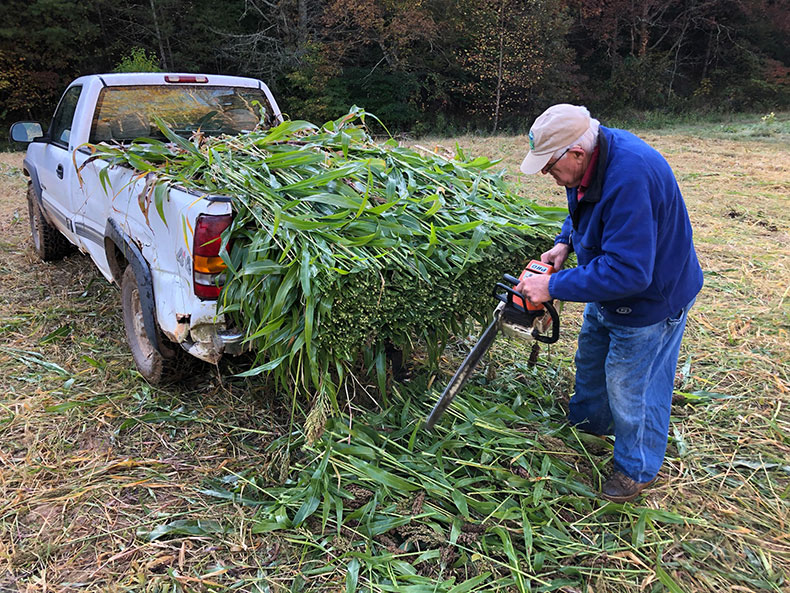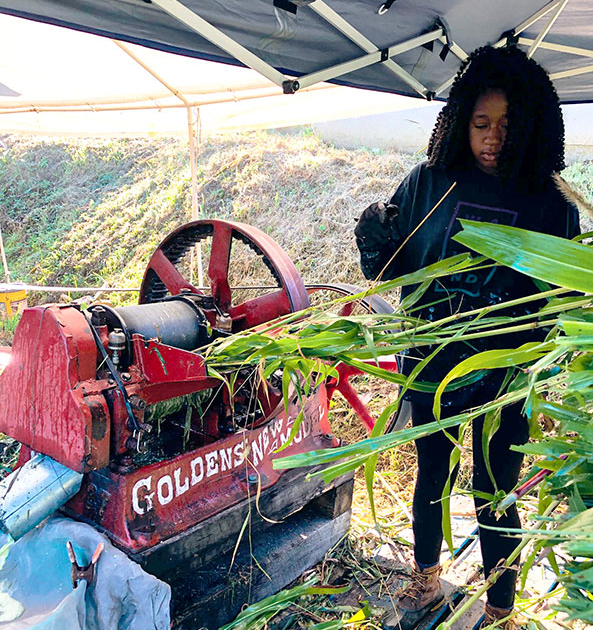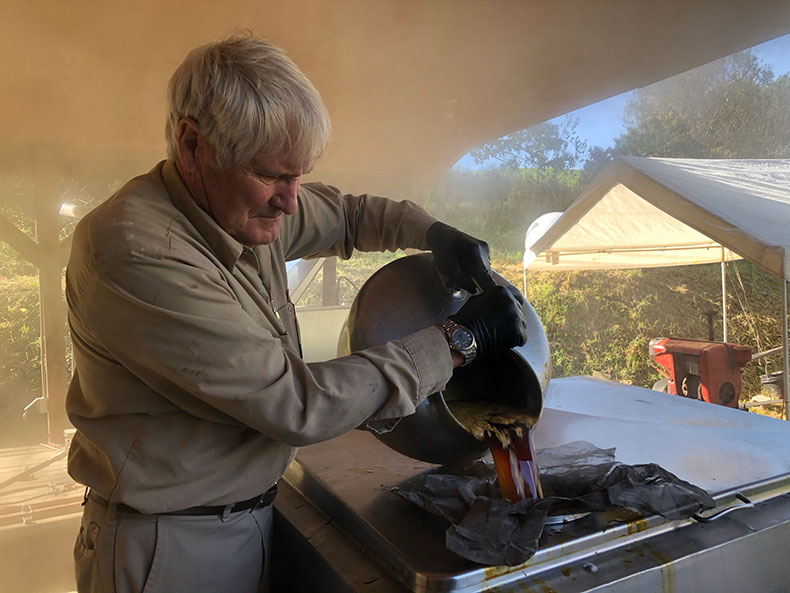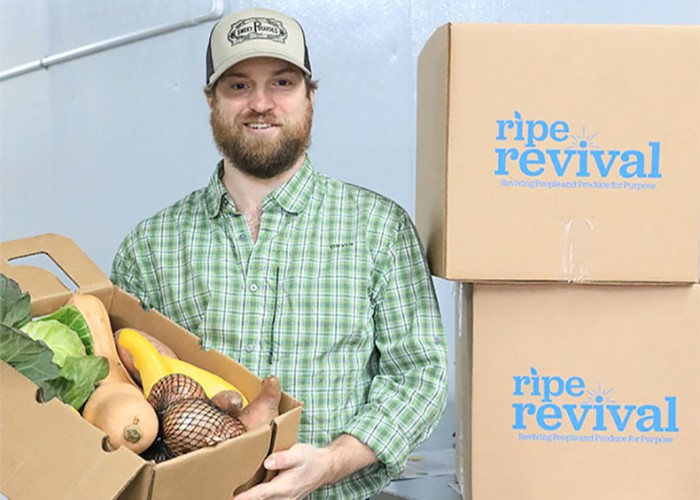Sweet, Syrupy Goodness
A culinary adventure following sorghum from field to biscuits
By Wendy PerryVideo courtesy of Green Sage/YouTube
Before I set out on my latest culinary adventure, this time to the heights of our Blue Ridge Mountains, I needed to understand: Is what I’ve always called “molasses” truly that? Or was it just syrup some of us grew up calling molasses? One thing was (and remains) clear: I love it.
My earliest recollections of this tasty elixir was the jar, always there, on my grandma’s kitchen work table, beside a plate of soft butter and biscuits she’d made that morning. A great uncle had a “molasses cook’n” each fall when I was growing up, and Daddy would always take me there.
As a grownup, with never-ending curiosity for learning about and documenting “old-timey” food preparation methods, I road-tripped out to Western North Carolina to spend a day with one of the few NC farmers — Mr. Doug Harrell — still making sorghum syrup, or what he calls molasses syrup (and what I’ll just call the good stuff), the old way. I had a feeling I’d be putting all of my senses to work on this trip.
Out in the field

Mr. Doug readies loaded sorghum for processing by trimming the seed heads, which are sometimes fed to his cattle.
Meandering my way down winding back roads of Mitchell County as the sun was peeping through the trees, I was feeling a bit giddy, eager for the day ahead. When I arrived at Harrell Hill Farms on a cooking day last September, I could see the community spirit there at the molasses cookhouse, where family and friends were gathered. Mr. Doug, whose kind, gentle spirit and eagerness to share were immediately apparent on a prior phone call, moseyed over to greet me. He gave me a hug, as if we were longtime friends, this gentleman in his well-broke-in overalls, as comfortable as a second skin.
“Hop in the truck, Wendy,” he exclaimed. “Let’s go to the field!”
The sun was just up, and no time to waste.
Somehow, our ride — a tattered old truck — got us through a few mud pits along the path, remnants of Hurricane Laura that had skimmed through a few days prior and briefly delayed harvest.
As we came out from the wooded trail into an open field, we were met by a few of his 21 grandchildren, neighborhood youth and some 4-Hers, there to swoop up armfuls of the tall golden-green sorghum. Mr. Doug hopped on his tractor and quickly mowed down rows of stalks, which they loaded into the truck bed.
I took a deep breath of the pure, brisk mountain air, listening to the quiet crunch underfoot of the freshly mown sorghum as it was gathered.
Into the mill

Back at the cook shed, Lil’ Bit feeds the mill at just the right pace to crush juice from the stalks of freshly cut sorghum.
Mr. Doug’s granddaughter, Ashlyn “Lil’ Bit” McDaniel, hopped in the truck with us, and back to the cook shed we went with the first of many loads of sorghum. For hours on end, Lil’ Bit fed stalks into the cane mill, a chug-a-lug contraption from 1903, still doing its duty today. The room filled with the raw aroma of fresh-crushed juice being strained and fed into a big repurposed dairy milk vat, where it would cook for hours for the next day’s syrup. I was fascinated to see how what looked like pond scum being extracted came to be liquid deliciousness.
The boiled juice from yesterday’s harvest was slowly released into the mazed evaporator cooking pan, watched over so carefully by Mr. Doug’s brother, Larry. He’s the expert at this, continually stirring the mixture and skimming off impurities while keeping a close eye on the temperature. As the syrup cooked down and moved through the vats to the perfect temperature (between 232 and 243 degrees), a rich smell arose. The syrup reached the end of the pan, free of impurities and ready to move to the vat for bottling.
Off to the table

Larry carefully moves the finished hot syrup from the evaporator into the cooling and bottling tank.
Mr. Doug’s daughter, Cyndi, turned a valve on and off, hundreds of times, meticulously bottling each and every jar of syrup. She’d then lower each into a vat of water to cool before boxing them up for local grocers, restaurants and a few family and friends.
It was there, holding my finger under that spigot for a drip, where I got my first taste of the day’s work. It was as good, no, better than any I could remember. I had seen all of the love and community spirit poured into each and every jar. And could taste it, too.
My heart was touched by Mr. Doug’s love of his trade, family and friends, and the legacy he is leaving on this community and land. Was I surprised to learn he was recently ordained as a minister? Or that a 2017 leukemia diagnosis hasn’t slowed him down? Nope.
“Wendy, I just want to show folks that no matter what comes our way, we just have to keep on, and let Jesus lead the way,” Mr. Doug said.
Mr. Doug has been a steward of the farm, worked by his family since Hugh Harrell was granted the land in 1796, and his son has recently decided to move from Arizona to continue the family legacy.
I’ll admit: I’m still a tad confused about the whole syrup/molasses thing. Technically, molasses is derived from sugar cane, and sorghum syrup comes from the sorghum like you’ll find on Harrell Hill Farms. But Mr. Doug calls his “molasses syrup,” since some of his customers call it one thing and some another. So we’ll go with that. Now, pass me a biscuit, please.

To buy your own
Harrell Hill Farms sells both sorghum syrup molasses as well as grass-fed beef directly from its farm. Please call or email first to check availability.
Harrell Hill Farms467 Byrd Road, Bakersville, NC 28705
828-467-0280
dougharrell68@gmail.com
-
Carolina people, places and pride
-
Share this story:





